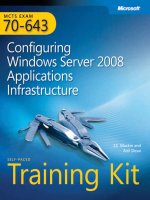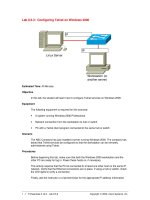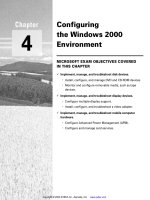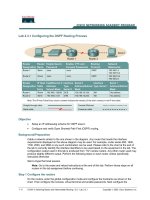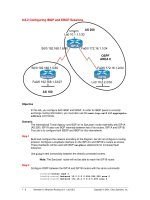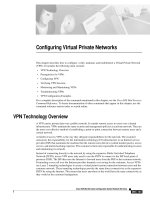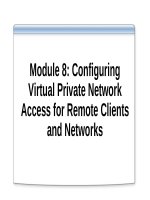70 247 configuring deploying private cloud 632 pdf
Bạn đang xem bản rút gọn của tài liệu. Xem và tải ngay bản đầy đủ của tài liệu tại đây (20.67 MB, 358 trang )
Exam Ref 70-247 Configuring and Deploying a
Private Cloud
Orin Thomas
PUBLISHED BY
Microsoft Press
A Division of Microsoft Corporation
One Microsoft Way
Redmond, Washington 98052-6399
Copyright © 2014 by Orin Thomas
No part of the contents of this book may be reproduced or transmitted in any form or by any means
without the written permission of the publisher.
Library of Congress Control Number: 2014946866
ISBN: 978-0-7356-8618-2
Printed and bound in the United States of America.
First Printing
Microsoft Press books are available through booksellers and distributors worldwide. If you need
support related to this book, email Microsoft Press Book Support at Please
tell us what you think of this book at />This book is provided “as-is” and expresses the author’s views and opinions. The views, opinions
and information expressed in this book, including URL and other Internet Web site references, may
change without notice.
Some examples depicted herein are provided for illustration only and are fictitious. No real
association or connection is intended or should be inferred.
Microsoft and the trademarks listed at on the “Trademarks” Web page are
trademarks of the Microsoft group of companies. All other marks are property of their respective
owners.
Acquisitions Editor: Alison Hirsch
Developmental Editor: Karen Szall
Editorial Production: Troy Mott, Martin Murtonen
Technical Reviewer: Telmo Sampaio
Copyeditor: Christina Rudloff
Indexer: Judy Hoer
Cover: Twist Creative • Seattle
Contents at a glance
Introduction
Preparing for the exam
CHAPTER 1
Design and deploy System Center
CHAPTER 2
Configure System Center infrastructure
CHAPTER 3
Configure the fabric
CHAPTER 4
Configure System Center Integration
CHAPTER 5
Configure and deploy virtual machines and services
Index
Contents
Introduction
Microsoft certifications
Free ebooks from Microsoft Press
Errata, updates, & book support
We want to hear from you
Stay in touch
Preparing for the exam
Chapter 1: Design and deploy System Center
Objective 1.1: Design a scalable System Center architecture
Understanding System Center 2012 R2 products
Examining System Center 2012 R2 high availability
Backing up and recovering VMM
Objective summary
Objective review
Objective 1.2: Install the System Center infrastructure
Understanding hardware requirements
Software prerequisites
Installing System Center 2012 R2 products
Objective summary
Objective review
Objective 1.3: Upgrade System Center components
Upgrading or migrating from versions prior to System Center 2012
Upgrading between System Center 2012, System Center 2012 SP1, and 2012 R2
Objective summary
Objective review
Answers
Objective 1.1: Thought experiment
Objective 1.1: Review
Objective 1.2: Thought experiment
Objective 1.2: Review
Objective 1.3: Thought experiment
Objective 1.3: Review
Chapter 2: Configure System Center infrastructure
Objective 2.1: Configure System Center components
Understanding Data Protection Manager
Understanding System Center agents
Run As accounts and Run As profiles
Assigning user roles
Understanding Operations Manager watcher nodes
Operations Manager gateway servers
Objective summary
Objective review
Objective 2.2: Configure portals and dashboards
Using App Controller
Using Service Manager Self-Service Portal
Creating Operations Manager dashboards
Application Performance Monitoring
Objective summary
Objective review
Answers
Objective 2.1: Thought experiment
Objective 2.1: Review
Objective 2.2: Thought experiment
Objective 2.2: Review
Chapter 3: Configure the fabric
Objective 3.1: Configure the storage fabric
Understanding VMM storage
Understanding storage classifications
Understanding file shares and VMM
Creating storage pools from physical disks
Provisioning storage logical units
Objective summary
Objective review
Objective 3.2: Configure the network fabric
Understanding VMM logical networks
Applying logical switches
Network virtualization
Virtual machine networks
Understanding MAC address pools
Creating static IP address pools
Implementing private VLANS
Windows Server Gateway
Objective summary
Objective review
Objective 3.3: Configure and manage the deployment and update servers
Adding a PXE server to VMM
Adding an WSUS server to VMM
Objective summary
Objective review
Objective 3.4: Configure clouds and virtualization hosts
Creating VMM host groups
Understanding VMM private clouds
Objective summary
Objective review
Answers
Objective 3.1: Thought Experiment
Objective 3.1: Review
Objective 3.2: Thought experiment
Objective 3.2: Review
Objective 3.3: Thought Experiment
Objective 3.3: Review
Objective 3.4: Thought experiment
Objective 3.4: Review
Chapter 4: Configure System Center Integration
Objective 4.1: Configure private cloud integration
Integrating Operations Manager
Orchestrator integration packs
Configuring other System Center connectors
Integrating IPAM with VMM
Objective summary
Objective review
Objective 4.2: Configure integration of private and public clouds
Understanding Service Provider Foundation
Deploying Service Provider Foundation
Understanding Microsoft Azure Pack for Windows Server
Objective summary
Objective review
Answers
Objective 4.1: Thought experiment
Objective 4.1: Review
Objective 4.2: Thought experiment
Objective 4.2: Review
Chapter 5: Configure and deploy virtual machines and services
Objective 5.1: Configure profiles
Creating hardware profiles
Creating guest operating system profiles
Creating application profiles
Configuring SQL Server profiles
Objective summary
Objective review
Objective 5.2: Create and configure Server App-V packages
Server App-V
Understanding Server App-V packages
Sequencing applications
Deploying a Server App-V package
Objective summary
Objective review
Objective 5.3: Configure and deploy a service
Configuring virtual machine templates
Creating service templates
Understanding Web Deploy packages
SQL DAC packages
Objective summary
Objective review
Objective 5.4: Update a service
Updating Services in VMM
Scaling out a service tier
Objective summary
Objective review
Answers
Objective 5.1: Thought experiment
Objective 5.1: Review
Objective 5.2: Thought experiment
Objective 5.2: Review
Objective 5.3: Thought experiment
Objective 5.3: Review
Objective 5.4: Thought experiment
Objective 5.4: Review
Index
What do you think of this book? We want to hear from you!
Microsoft is interested in hearing your feedback so we can continually improve our books and learning resources for you. To
participate in a brief online survey, please visit:
www.microsoft.com/learning/booksurvey/
Introduction
The 70-247 exam deals with advanced topics that require candidates to have an excellent working
knowledge of both Windows Server 2012 R2 and the products in the System Center 2012 R2 suite.
Much of the exam comprises topics that even experienced systems administrators may rarely
encounter unless they work with Virtual Machine Manager, Orchestrator, Service Manager, Data
Protection Manager, and Operations Manager on a day-to-day basis. To be successful in taking this
exam, a candidate not only needs to know how each of these products works when used by itself, but
how the products in the System Center suite work together when used to monitor and operate a private
cloud.
Candidates for this exam are Information Technology (IT) Professionals who want to validate their
advanced Windows Server 2012 R2 operating system and System Center 2012 R2 management skills,
configuration skills, and knowledge. To pass this exam, candidates require strong understanding of
how to design a System Center deployment, configure System Center infrastructure, configure fabric
resources, configure System Center integration, and how to configure and deploy virtual machines and
services. To pass, candidates require a theoretical understanding, as well as meaningful practical
experience implementing the technologies involved.
This book covers every exam objective, but it does not cover every exam question. Only the
Microsoft exam team has access to the exam questions themselves and Microsoft regularly adds new
questions to the exam, making it impossible to cover specific questions. You should consider this
book a supplement to your relevant real-world experience and other study materials. If you encounter
a topic in this book that you do not feel completely comfortable with, use the links you’ll find in text
to find more information and take the time to research and study the topic. Great information is
available on TechNet, through MVA courses, and in blogs and forums.
Microsoft certifications
Microsoft certifications distinguish you by proving your command of a broad set of skills and
experience with current Microsoft products and technologies. The exams and corresponding
certifications are developed to validate your mastery of critical competencies as you design and
develop, or implement and support, solutions with Microsoft products and technologies both onpremises and in the cloud. Certification brings a variety of benefits to the individual and to employers
and organizations.
More Info: All Microsoft Certifications
For information about Microsoft certifications, including a full list of available
certifications, go to />
Free ebooks from Microsoft Press
From technical overviews to in-depth information on special topics, the free ebooks from Microsoft
Press cover a wide range of topics. These ebooks are available in PDF, EPUB, and Mobi for Kindle
formats, ready for you to download at:
/>Check back often to see what is new!
Errata, updates, & book support
We’ve made every effort to ensure the accuracy of this book and its companion content. You can
access updates to this book—in the form of a list of submitted errata and their related corrections—
at:
/>If you discover an error that is not already listed, please submit it to us at the same page.
If you need additional support, email Microsoft Press Book Support at
Please note that product support for Microsoft software and hardware is not offered through the
previous addresses. For help with Microsoft software or hardware, go to
.
We want to hear from you
At Microsoft Press, your satisfaction is our top priority, and your feedback our most valuable asset.
Please tell us what you think of this book at:
/>The survey is short, and we read every one of your comments and ideas. Thanks in advance for
your input!
Stay in touch
Let’s keep the conversation going! We’re on Twitter: />
Preparing for the exam
Microsoft certification exams are a great way to build your resume and let the world know about your
level of expertise. Certification exams validate your on-the-job experience and product knowledge.
While there is no substitution for on-the-job experience, preparation through study and hands-on
practice can help you prepare for the exam. We recommend that you round out your exam preparation
plan by using a combination of available study materials and courses. For example, you might use this
Exam Ref and another study guide for your “at home” preparation and take a Microsoft Official
Curriculum course for the classroom experience. Choose the combination that you think works best
for you.
Note that this Exam Ref is based on publically available information about the exam and the
author’s experience. To safeguard the integrity of the exam, authors do not have access to the live
exam.
Chapter 1. Design and deploy System Center
One of the first steps in deploying a private cloud using Microsoft technologies is the deployment of
the System Center products that you will use to manage that private cloud. In this chapter you will
learn which System Center products are appropriate for particular tasks within the private cloud, how
to install those products, how to make those products highly available, how to back up and recover
those products, and how to upgrade some of those products from previous versions.
Important: Have you read page xv?
It contains valuable information regarding the skills you need to pass the exam.
Objectives in this chapter:
Objective 1.1: Design a scalable System Center architecture
Objective 1.2: Install the System Center infrastructure
Objective 1.3: Upgrade System Center components
Objective 1.1: Design a scalable System Center architecture
This objective deals with knowing which System Center products you would deploy to accomplish
specific goals in a private cloud deployment, how you can make those System Center products highly
available, and how to back up and recover those System Center products.
This objective covers the following topics:
Understanding System Center 2012 R2 products
Examining System Center 2012 R2 high availability
Backing up and recovering VMM
Understanding System Center 2012 R2 products
Each System Center 2012 R2 product plays a different role within a private cloud environment.
Understanding which product you would leverage to complete each task is an important part of the
70-247 exam. The following pages provide a brief description of the basic purpose of each System
Center 2012 R2 product in a private cloud deployment.
Virtual Machine Manager
Virtual Machine Manager (VMM) allows you to manage your organization’s virtualization
infrastructure, including virtualization hosts, storage, and networking resources. You can use VMM to
create, manage, deploy, and update VMs. You can also use VMM to create, manage, deploy, and
update applications and services that are hosted within your organization’s private cloud. VMM
supports management of virtualization hosts running Hyper-V, VMware ESX and ESXi, as well as
Citrix Xen.
You can use VMM to perform the following tasks:
Automatically place new VMs on virtualization hosts that have the most available resources.
This feature is termed intelligent placement.
Automatically move virtual machines between cluster nodes based on cluster node workload
and available resources. This includes evacuating VMs off of host cluster nodes so that VMM
can shut those nodes down to preserve electricity.
Deploy and manage Server App-V applications.
Manage the process of VM live migration between virtualization hosts.
Manage software updates for VMM infrastructure, including VMM servers and virtualization
hosts.
More Info: Virtual Machine Manager
You can learn more about Virtual Machine Manager at
/>App Controller
App Controller includes a Self-Service Portal. You can grant access to this Self-Service Portal to
allow users to deploy services and applications to your organization’s private cloud, as well as to the
Microsoft Azure public cloud. You grant access by delegating the appropriate roles and permissions.
App Controller allows an application’s owner to scale out, or scale back in, an application. Scaling
out allows the application to have access to increased resources as demand for those resources
escalates. In System Center 2012 R2, App Controller functions as VMM’s Self-Service Portal.
Previous versions of VMM had their own Self-Service Portal.
More Info: App Controller
You can learn more about App Controller at
/>Orchestrator
Orchestrator provides a drag-and-drop interface, allowing you to build complicated automation
runbooks. A runbook is a branching automation workflow. You create runbooks by connecting
together Orchestrator tasks. Integration packs are collections of tasks. Microsoft provides integration
packs for each of the System Center products. Using the tasks contained within these integration
packs, you can build complicated runbooks that enact intricate tasks. For example, you could create a
runbook that deploys a VM from a template using VMM in response to an alert raised in Operations
Manager, and then configures protection for that VM using Data Protection Manager. You use
Orchestrator runbooks to automate activities in a private cloud deployment.
More Info: Orchestrator
You can learn more about Orchestrator at
/>
Operations Manager
Operations Manager allows you to monitor the performance and availability of private cloud
elements, from being able to monitor individual virtualization hosts, through to monitoring specific
virtual machines, and applications that run on those virtual machines and within the private cloud.
Operations Manager supports automatic remediation of some problems. You can enhance the
capability of Operations Manager by importing product-specific management packs.
More Info: Operations Manager
You can learn more about Operations Manager at
/>Service Manager
Service Manager is a service management product that you can use to manage incidents and problems
in a manner consistent with ITIL (Information Technology Infrastructure Library) or MOF (Microsoft
Operations Framework) practices. You can configure Service Manager with connectors to Operations
Manager.
You can configure Service Manager to trigger Orchestrator runbooks and publish this to the Service
Manager Self-Service Portal as a service offering. For example, you could create an Orchestrator
runbook that places a designated SQL Server database hosted in the private cloud into protection
using Data Protection Manager. You could use Service Manager to publish this runbook automation as
a service offering on the Self-Service Portal. Users could then use the Self-Service Portal to interact
with the service offering, putting their SQL Server workload into protection without having to directly
interact with Orchestrator or Data Protection Manager.
More Info: Service Manager
You can learn more about Service Manager at
/>Data Protection Manager
Data Protection Manager (DPM) is Microsoft’s backup and recovery solution. You use Data
Protection Manager to provide protection for your private cloud workloads. In addition to providing
protection for physically deployed workloads, DPM supports backup and recovery of virtual
machines running on Hyper-V virtualization hosts. This can take the form of fully recovering a VM to
the original or a different Hyper-V host, or allows for item level recovery of elements within the
protected VM. You can use DPM to perform the following tasks:
Perform bare metal recovery of protected Windows servers and desktops.
Back up and recover from disk, tape, or Microsoft Azure.
Manage multiple DPM servers from a single console.
Configuration Manager
Configuration Manager provides you with the ability to manage the configuration of computers and
devices, including virtual machines deployed in a private cloud. You can use Configuration Manager
to:
Deploy operating systems, software applications, software, updates, and operating system
updates.
Monitor and correct operating system and application compliance settings.
Collect hardware and software inventory.
Perform remote administration.
In a private cloud environment, you would use VMM to manage virtual machine deployment, but
might use Configuration Manager to manage software updates and monitor configuration drift for
existing virtual machines.
Exam Tip
Remember that you use VMM to manage the software updates of your virtualization
infrastructure, which includes the virtualization hosts and VMM servers. You could do
this with Configuration Manager, but doing it with VMM has the benefit of ensuring that
VMs are properly dealt with before a virtualization host is updated. You would use
Configuration Manager to manage the software updates of the virtual machines that were
deployed and running within your organization’s private cloud.
More Info: Configuration Manager
You can learn more about Configuration Manager at
/>
Examining System Center 2012 R2 high availability
The most straightforward method of making the server that hosts a System Center product highly
available is to deploy that product within a highly available virtual machine. Additional protection is
possible by configuring a replica virtual machine hosted on a second failover cluster.
You can make the databases for each System Center product highly available by deploying the
databases on:
A SQL Server instance hosted on a highly available virtual machine
A SQL Server failover cluster
SQL Server availability groups
Using availability groups with System Center product databases involves substantial configuration
of SQL Server prior to the deployment of the System Center product. You’ll have to specify the
availability group listener name during product setup.
Beyond deploying the product on a highly available virtual machine, Table 1-1 lists additional high
availability strategies for each System Center product.
TABLE 1-1
System Center high availability options
Backing up and recovering VMM
Perhaps the simplest method of protecting System Center products is to deploy them in virtual
machines. Once you’ve done that, you can then configure DPM to protect those virtual machines.
When recovering a VM protected by DPM, you can choose to recover the VM, or you can perform
item level recovery. When recovering a VM, you can choose to recover the VM to its original
location or to a separate Hyper-V host that has the DPM agent deployed. Item level recovery allows
you to choose to recover specific files or folders from a VM, rather than having to recover the VM in
its entirety.
More Info: Virtual Machine Recovery
You can learn more about virtual machine recovery at />VMM
In order to recover a VMM deployment, you need to have a backup of the VMM database. You should
also have a backup of the files stored in the VMM library. Microsoft recommends that you perform a
full back up of the VMM database every 7 days and perform an incremental back up of the VMM
database every day. You should back up at least one VMM library server whenever you substantially
modify content stored on the server.
You can back up the VMM database using the VMM console, by using SQL Server Management
Studio, or by configuring protection for the database using DPM. To back up the VMM database using
the VMM console, perform the following steps:
1. In the Settings workspace of the VMM console, click Backup in the ribbon.
2. In the Virtual Machine Manager Backup dialog box, specify the location that will store the
backup file.
You can restore the VMM database using SQL Server Management Studio, DPM, or by using the
SCVMMRecover.exe utility from an elevated command prompt on the server that hosts VMM.
After restoring the VMM database, you will need to perform the following steps:
Manually remove any virtualization hosts that you had removed from VMM subsequent to when
you performed the backup.
Manually remove any VMs that you had removed from VMM subsequent to when you
performed the backup.
Manually add any virtualization hosts that had been added to VMM subsequent to when you
performed the backup.
If you restore the VMM database to a separate computer, you may need to reassociate any
virtualization hosts and library servers that display an Access Denied message.
More Info: Backing Up and Restoring VMM
You can learn more about backing up and restoring a VMM deployment at
/>
App Controller
All App Controller settings are stored within the App Controller database. You can use SQL Server
Management Studio or DPM to back up the App Controller database. To be able to recover the
database, you’ll need to ensure that you back up the App Controller AES key. You can back up the
App Controller AES key using the Export-SCACAesKey cmdlet.
If your App Controller deployment is otherwise functioning, you can restore the App Controller
database using either the SQL Server Management Studio tools or by using DPM. In the event that you
are reinstalling App Controller on a new computer, you’ll need to restore the App Controller
database and have access to the App Controller AES key before running the App Controller
Installation Wizard and specifying that you want to perform recovery using an existing database.
More Info: App Controller Backup and Restore
You can learn more about backing up and restoring App Controller at
/>Orchestrator
Backing up Orchestrator involves backing up the following elements:
Backup of the Orchestrator database
SQL instance service master key
File backup of the Orchestrator management server
File backup of each runbook server
File backup of each Orchestrator web server
Orchestrator runbooks are stored within the Orchestration database. As the Orchestration database
uses encryption, you will also need to back up the service master key. Without the service master key,
you will not be able to access the encrypted data stored in the Orchestration database if recovered to
a separate instance. You back up a service master key with the BACKUP SERVICE MASTER KEY
TO FILE Transact SQL statement.
On the management server, ensure that you back up the settings.dat file. This file stores information
that allows the Orchestrator program files to access the Orchestration database. For Orchestrator web
servers, ensure that the web.config files are being protected. DPM supports standard file backups of
Orchestrator.
More Info: Back Up Orchestrator
You can learn more about backing up Orchestrator at />Operations Manager
If you have not deployed Operations Manager within a VM, or if you want to just protect an
Operations Manager deployment without requiring that the host computer or VM also be able to be
recovered in its entirety, you should ensure that you regularly back up the following elements:
Operational database
Data warehouse database (if deployed)
Audit Collection Services (ACS) database (if deployed)
Custom management packs
Custom report definition files
Computer certificates
Microsoft recommends the backup schedule listed in Table 1-2 for an Operations Manager
deployment.
TABLE 1-2
Operations Manager data protection
You can use SQL Server Management Studio to configure regular database backups. In a private
cloud environment where you have deployed DPM, you should configure a custom DPM protection
group to manage backups for Operations Manager. You back up custom management packs by
exporting them using the Management Packs node of the Administration workspace of the Operations
Manager console.
You perform recovery by restoring the appropriate databases, either using SQL Server Management
Studio or by using DPM. You recover custom management packs by importing them using the
Operations Manager console.
More Info: Backing Up Operations Manager
You can learn more about backing up Operations Manager at
/>Service Manager
Backing up Service Manager involves backing up the following elements:
Service Manager encryption keys
Service Manager database
Service Manager data warehouse database
You can back up the Service Manager encryption keys using the SecureStorageBackup.exe
command line utility from an elevated command prompt. You can back up the Service Manager
database and the data warehouse database using SQL Server Management Studio or by using DPM.
To recover a Service Manager deployment, perform the following general steps:
1. Restore the encryption key.
2. Install the new Service Manager management server on a computer that has the same name as
the original management server.
3. In the event that SQL Server was also installed on the Service Manager management server,
install SQL Server and restore the Service Manager database.
4. Run the Service Manager Installation Wizard, and select the Use An Existing Database option,
providing the details of the SQL instance that hosts the Service Manager database.
More Info: Service Manager Disaster Recovery
You can learn more about Service Manager disaster recovery at
/>Data Protection Manager
Just because DPM functions as a data protection solution for other elements of your private cloud
deployment, doesn’t mean that you don’t need to back up the DPM server itself. Your protection
strategy for the DPM server should include backing up:
The DPM database
All local volumes and application data on the computer that hosts DPM
All replicas on the DPM server protected by that DPM server
There are two general strategies that you can use to protect a DPM server. These are:
Back up the DPM server using a second DPM server When you configure DPM in this way,
the second DPM server functions as a replica of the first DPM server. In the event that the first
DPM server fails, the secondary server will start protecting all of the workloads that were
previously protected by the primary DPM server. Should it be necessary, you can configure a
tertiary DPM server that will function as a replica of the secondary DPM server.
Back up the DPM database to tape You can configure DPM to back up the DPM database to
a tape library. To recover the DPM database from tape, you’ll need to uninstall DPM from the
original server, remove the DPM database that you want to restore using SQL Server
Management Studio, reinstall DPM, perform a tape inventory, re-catalog the imported tape,
recover the database to a network folder, and then use the DPMSync.exe utility to attach the
database to DPM. You’ll need to then reestablish protection for all computers that were
protected by the DPM server. You can do this by running the setdpmserver.exe command on
each protected computer.
More Info: Backing Up DPM
You can learn more about backing up DPM at />Configuration Manager
Configuration Manager includes a backup maintenance task that runs on a schedule. This task, shown
in Figure 1-1, is available through the Site Maintenance item on the ribbon, which you can open when
you select the Sites node in the Administration workspace of the Configuration Manager console. The
Configuration Manager Backup Site Server site maintenance task backs up the following:
Site database
Configuration Manager registry keys
Configuration Manager files and folders
FIGURE 1-1
Backup site server task
DPM supports protecting Configuration Manager as a workload. When creating a DPM protection
group for Configuration Manager, ensure that you select the SMS Writer Service item, and the site
database on the Configuration Manager server.
More Info: Configuration Manager Backup and Recovery
You can learn more about Configuration Manager backup and recovery at
/>If your organization uses custom Reporting Services reports with Configuration Manager, you will
need to ensure that the following are protected:
Report Server database
Source files for reports and models
Encryption keys
Custom assemblies or extensions
Configuration files
Custom SQL views
Custom stored procedures
The backup site server scheduled maintenance task does not backup content files for software
updates, applications, or operating system deployment. You should back up the SCCMContentLib
folder on the Configuration Manager site server, using file backup to backup the content library. You
will also need to ensure that you have taken a file backup of package source files. If you have not kept
track of the location of package source files, you can determine the location by using the following
Transact SQL query against the Configuration Manager database as shown in Figure 1-2:
Click here to view code image
SELECT PackageID, Name, PkgSourcePath FROM v_Package
FIGURE 1-2
Package source location
When recovering a site server, you can choose one of the following options:
Recover the site server using an existing backup You can leverage this option if you have
created a backup using the scheduled maintenance task.
Reinstall the site server Only use this option if you don’t have a backup of the site server.
When using this option, ensure that you use the same site code and site database name as the
original site server.
It will be necessary to recover the Configuration Manager database if the database becomes
corrupted or if the data is otherwise lost. If you are recovering a database in a hierarchy, any changes
made to the site database since the backup will be retrieved from the central administration site if you
are recovering a primary site database, or from a primary site database if you are recovering the
central administration site. If you are recovering the database of a stand alone primary site, all
changes made subsequent to the backup will be lost.
When performing database recovery, you have the following recovery options:
Recover the site database using a backup set This option allows you to restore the database
using the backup created using the scheduled maintenance task.
Use a site database that has been manually recovered You use this option if you use SQL
Server Management Studio, DPM, or another tool to back up the Configuration Manager
database.
Create a new database for this site Use this option if you do not have access to a backup of
the Configuration Manager site database. This option is only available if the site is part of a
Configuration Manager hierarchy. You cannot use this option to recover the site database of a
CAS if no primary sites are present and you can’t use this option to recover the site database of
